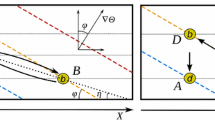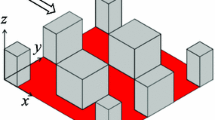Abstract
A quasi-one-dimensional numerical model containing a prognostic turbulent kinetic energy parameterization and simplified approximations to horizontal gradients is used to study interactions of thermally induced nocturnal slope flows with following and opposing ambient winds. It is found that a following ambient wind causes the peak perturbation wind to be weaker and to be realized at a greater height, while an opposing ambient wind leads to a stronger perturbation wind at a lower height. The reason for this response lies in the interactions of the shears of the thermal and ambient components through the mechanical production of turbulent kinetic energy.
Similar content being viewed by others
References
Defant F.: 1951, ‘Local Winds’, Compendium of Meteorology, American Meteorological Society, pp. 655–672.
Delage, Y.: 1974, ‘A Numerical Study of the Nocturnal Atmospheric Boundary Layer’, Quart. J. Roy. Meteorol. Soc. 100, 351–364.
Dickerson, M. H. and Gudiksen, P. H.: 1983, Atmospheric Studies in Complex Terrain: Technical Progress Report FY-1979 through FY-1983, 367 pp.
Doran, J. C. and Horst, T. W.: 1983, ‘Observations and Models of Simple Nocturnal Slope Flows’, J. Atmos. Sci. 40, 708–717.
Egan, B. A.: 1984, ‘Transport and Diffusion in Complex Terrain (Review)’, Boundary-Layer Meteorol. 30, 3–28.
Fitzjarrald, D. R.: 1984, ‘Katabatic Wind in Opposing Flow’, J. Atmos. Sci. 41, 1143–1158.
Horst, T. W. and Doran, J. C.: 1982, Simple Nocturnal Slope Flow Data from the Rattlesnake Mountain Site, Pacific Northwest Laboratory, Richland, Washington U.S.A., 98 pp.
Lykosov, V. N. and Gutman, L. N.: 1972, ‘Turbulent Boundary Layer Above a Sloping Underlying Surface’, Izv. Atmos. Ocean. Phys. 8, 799–809.
Mannouji, N., 1982: ‘A Numerical Experiment on the Mountain and Valley Winds’, J. Meteorol. Soc. Japan 60, 1085–1105.
McNider, R. T. and Pielke, R. A.: 1981, ‘Diurnal Boundary-Layer Development Over Sloping Terrain’, J. Atmos. Sci. 38, 2198–2212.
McNider, R. T. and Pielke, R. A.: 1984, ‘Numerical Simulation of Slope and Mountain Flows’, J. Clim. Appl. Meteorol. 23, 1441–1453.
Mellor, G. L. and Yamada, T.: 1982, ‘Development of a Turbulence Closure Model for Geophysical Fluid Problems’, J. Geophys. Res. 20, 851–875.
O'Brien, J. J.: 1970, ‘A Note on the Vertical Structure of the Eddy Exchange Coefficient in the Planetary Boundary Layer’, J. Atmos. Sci. 27, 1213–1215.
Pielke R. A.: 1984, Mesoscale Meteorological Modeling, Academic Press, 612 pp.
Prandtl, L.: 1942, Fuhrer durch die Stromungslehre, Verslag Vieweg und Sohn, Braunschweig, Germany.
Rao, K. S. and Snodgrass, H. F.: 1981, ‘A Nonstationary Nocturnal Drainage Flow Model’, Boundary-Layer Meteorol. 20, 309–320.
Yamada, T.: 1983, ‘Simulations of Nocturnal Drainage Flows by a q 2 l turbulence Closure Model’, J. Atmos. Sci. 40, 91–106.
Author information
Authors and Affiliations
Rights and permissions
About this article
Cite this article
Arritt, R.W., Pielke, R.A. Interactions of nocturnal slope flows with ambient winds. Boundary-Layer Meteorol 37, 183–195 (1986). https://doi.org/10.1007/BF00122763
Revised:
Issue Date:
DOI: https://doi.org/10.1007/BF00122763




